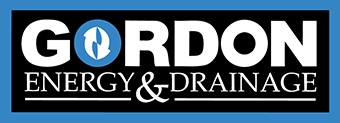Waterproofing Vs Dampproofing
PROS & CONS OF WATERPROOFING YOUR FOUNDATION VS. DAMPROOFING
Many homeowners and builders are faced with many options when they build a house. Each phase of building a home has so many options from the cheapest to most expensive choices. Do we choose granite countertops or formica? Do we choose a tile roof or composition shingles? Do we add a tyvek house air barrier? Do we do double wall construction? Do we make the exterior maintenance free? If a homeowner or homebuilder always chose the best option from each subcontractor, the price of the home would skyrocket.
It is entirely possible to build a 2,500 square foot home for $ 300,000. And, you can build the same exact floor plan on the exact same lot for $ 1,000,000. So, as the decision maker, we have to pick and choose where to make our upgrades.
There are choices to be made choosing what product to install on the exterior of the foundation walls. Gordon Energy & Drainage is a sub-contractor who offers many choices when it is time to protect the basement. They come in right after the foundation walls are set and just before the backfilling takes place. Do we install the typical builder-grade damproofing, or upgrade to a true rubber membrane waterproofing? Damproofing, is a black road type oil that is applied to the foundation walls. It looks like it would seal the basement and keep it from leaking. However, buyer beware!! Damproofing will not span a foundation wall crack. It does not have the elasticity needed to protect the basement from leaking if a crack forms. And we all know that concrete cracks over time. Once the builder warranty is expired, and a leak forms in the basement, you are on your own. These leaks can be expensive if you have a finished basement. Damproofing is very inexpensive. A typical Damproofing application on an average house is about $ 300. Gordon Energy & Drainage installs a damproofing product made by Tremco Barrier Solutions called Mulseal.
Waterproofing, on the other hand, is a true rubber membrane that is capable of spanning most foundation wall cracks. Most manufacturers are so positive that they give a warranty of 5-30 years. There are many types, brands, thicknesses, etc…. But, in general, they all can do the trick. Most waterproofing products are applied to about 60 mils and dry to 40 mils. They have elongation capabilities of over 1,000%. If you took a 2” square of a waterproofing membrane and pulled it apart, it wouldn’t break until your hands reached over 1’ apart!
No items found.
(The above is an actual sample piece of Tuff-N-Dri waterproofing membrane being stretched to simulate it’s ability to span a crack in a foundation wall)
Gordon Energy & Drainage installs 2 types of waterproofing products made by Tremco Barrier Solutions. The first and most economical of all waterproofing choices is called Watchdog. An average house would cost about $ 1,200, vs. $ 300 for damproofing. The second is called Tuf-N-Dri/Warm-n-Dri. It is a 2 part system comprised of a waterproofing membrane and an added drainage/insulation board. The Warm-N-Dri board is installed over the rubber membrane and it allows water to wick down to the drain tile system. It also adds an insulated R factor to the basement walls. An average house would cost about $ 3,000 for the Tuf-N-Dri/Warm-N-Dri system.
75% or more of all new homes built in the K.C. metro area utilize damproofing. That means that less than 25% of homeowners opt to upgrade in this particular case. Most builders say that homeowners like to spend their money on things they can see and touch. They don’t think of the consequences of upgrading things they can’t see. In many other markets across the country, like St. Louis, it is just the opposite. These markets do not even consider damproofing to be a choice. Kansas City has not caught on yet.
According to Tremco Barrier Solutions, 80% of all homes will have a partially finished basement within 10 years of the homes construction. That means that even if you don’t finish your basement when you build, you or anther homeowner probably will at some point. Most are not aware that the exterior of the foundation wall do not have a waterproofing membrane to protect their investment.

